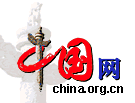The taozhong, the earliest kind of bell, appeared in primitive Chinese society. It was an instrument for labouring people to play after work. The introduction of metal brought about the tongnao (a bronze percussion instrument resembling an inverted bell, sounded by a hammer), tongling (a small bronze bell) and tongzhong (a bronze bell). Then they evolved into the bianling (a chime of small bells), biannao (a chime of percussion instruments resembling inverted bells) and bianzhong (a chime of bells).
Many chimes of bells appeared in the days before the Qin Dynasty (221 BC-206 BC) unified China. Most of them were shaped uniquely like combined pairs of tiles. They produced quick and short notes. Each bell could produce two different notes when the front and the side of its lower part were struck. So such bells were also known as double-note bells. As they were used mainly for performances, they were also called musical bells.
With the development of society and the elapse of time, the musical bells gradually became feudal sacrificial vessels and important symbols of power, rank and position of the ruling classes. According to The Junior Dancing Master, the Ministry of Rites, the Ritual of Zhou, "The emperor could have bells on the four sides of his palace, a duke or prince could have bells on three sides of his residence, a minister could have bells on two sides of his residence and an official could have bells on one side of his residence." This was a clear proof of the rigid hierarchy of power in those days.
Due to the differences in the uses, shapes and regional features and the evolution of times, the ancient Chinese percussion instruments before the Qin Dynasty were divided into the nao (an ancient percussion instrument resembling an inverted bell, sounded by a hammer), duo (a kind of bell used in ancient China when proclamations were issued or in times of war), zheng (a bell-shaped percussion instrument used in ancient times by troops on march), goudiao (a long and narrow bell), yongzhong (a bell with a cylindrical handle on top), niuzhong (a bell with a semi-circular knob on top), yangjiaozhong (a bell shaped like a ram's horns) and tongzhong (a tube-shaped bell).
With the introduction of Buddhism into China after the Qin Dynasty, ancient bells gradually became important musical instruments for Buddhism. As the saying goes, "There are bells at every temple. Without bells, there would be no temples." Round bells took the place of those shaped like combined pairs of tiles. The strokes of bells became sweet and sonorous, spreading to distant places.
With their imposing shapes and deep and prolonged sound, round bells were widely used in Buddhism and Taoism. They also entered the imperial court and became a symbol of imperial power. During the Ming and Qing dynasties, ancient Chinese bells were divided into musical bells, Buddhist bells, Taoist bells, imperial court bells and bells for sounding the night watches. Their functions and uses were broadened. According to a historical record, "Bells are the leading musical instruments made of metal. The peals of big ones can be heard five kilometers away and the strokes of small ones can reach places half a kilometer off. When a monarch held court or an official leaves his office, a hell is struck to call together their subordinates. A bell is struck at a feast to accompany the singing of songs. A bell is struck at a Buddhist or Taoist temple to draw the devotion of worshippers and the awe of ghosts and gods." In those days, bells served as musical instruments, sacrificial vessels and musical instruments used in Buddhist or Taoist masses, keeping up all the uses of bells during the pre–Qin period and the Sui, Tang, Song and Yuan dynasties.

